DISCLOSURE: THIS POST MAY CONTAIN AFFILIATE LINKS, MEANING I GET A COMMISSION IF YOU DECIDE TO MAKE A PURCHASE THROUGH MY LINKS, AT NO COST TO YOU. PLEASE READ MY DISCLOSURE FOR MORE INFO.
A beginners guide answering all your questions about how to sell on Etsy in 2021. Even as a brand new Etsy shop owner, you can build a successful online business through the Etsy marketplace.
Page Contents
What is Etsy?
Etsy is a global online marketplace where sellers can sell handmade goods, vintage items, and craft supplies. If you are looking for an unusual handmade gift, or love everything vintage, Etsy is the place you’ll find it. If you are an artist or an avid collector of unusual items, you can list your treasures for sale on Etsy and run your own business.
Etsy is not the only e-commerce site that you can use to sell your goods, though it has quickly become one of the most globally well-known.
In fact, there are currently more than 100 online marketplaces people use to entice consumers to buy from them. Each platform has its own benefits and drawbacks.
Other e-commerce sites include Facebook Marketplace, Shopify, EBay, Walmart, Target and behemoths like Amazon and Alibaba. Of course, you could also build your own website for e-commerce purposes. That is a great option for long-term success, but takes more time, money and strategy to launch.
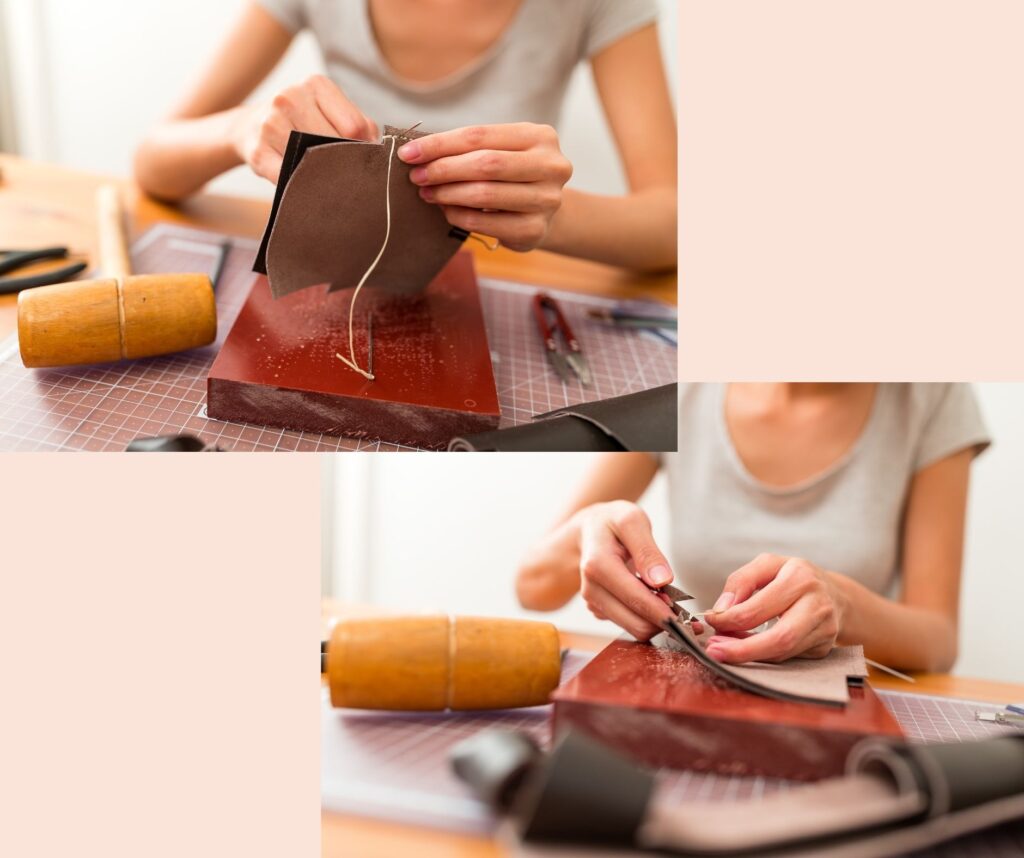
Why Sell on Etsy in 2021?
Huge market for your goods
Why would you sell on Etsy? Well, the size of this marketplace is nothing to scoff at. According to Statista, there were more than 2.5 million sellers on Etsy on the last count. Additionally, the platform had a whopping 39.4 million buyers worldwide.
A truly global marketplace, Etsy has sellers from 234 countries. Most of them are from the United States (62%) as of June 2019 and 13% are from the UK.
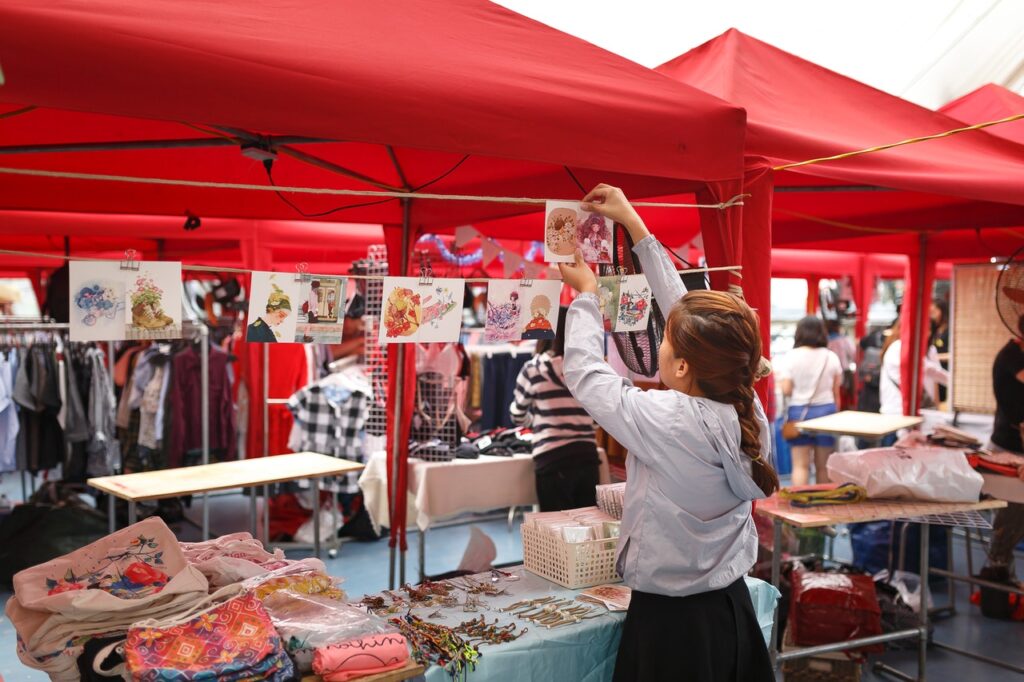
The company is growing
Etsy has seen phenomenal growth since its founding in June 2005 by founders Rob Kalin, Chris Maguire, Jared Tarbell, and Haim Schoppik. Ten years after the company’s founding, in April 2015, Etsy became a publicly traded company. They traded on the NYSE at a valuation in excess of $3.5 billion while raising more than $287 million. At the time of this article, Etsy is valued at $2 billion.

Etsy supports sellers with TV ads
Etsy recently launched the ‘’Stand with Small campaign’’, which reminds buyers that by shopping on Etsy they are supporting someone’s small business. Shopping small supports creative entrepreneurs at a time when they could be struggling to make ends meet.
Etsy’s latest campaign ‘’Always Open’’, features actual Etsy sellers from around the world and the unusual items they create.
Etsy sellers can be very successful
It’s possible to run a very successful business on the Etsy platform. Some sellers have managed to make serious money with their shops. Others have been able to grow their Etsy shops into profitable full-time businesses. Two outstanding success stories are Three Bird Nest and Bohemian Findings.
Alicia Shaffer, famously referred to as Etsy’s richest seller, attributes her success to how she presented her products photographically. She styles every product with accessories to make sure it is presented to its best potential. Her shop, Three Bird Nest, raked in almost $1 million on Etsy in 2015. She has since opened her own website where she hosts her shop.
Bohemian Findings sells charms and beads on Etsy and is one of the site’s most successful stores. Bohemian Findings sells everything you need to make jewelry. Many of their customers happen to be other Etsy sellers who make and sell jewelry. What a clever business providing what other Etsy shop owners need!
Bohemian Findings has also since launched its own ecommerce site. At one point they were receiving an unbelievable 500 orders a day on Etsy!
It’s easy to start a shop on Etsy
Opening a shop on Etsy is simple and affordable. It’s an ideal e-commerce platform for small-scale businesses that focus on a niche market.
To start your own store, simply create an Etsy account, set your shop location and currency (based on where you are in the world).
Then you name your shop and create your first listing.

You will also have to set up a preferred payment method for how you will accept payments and a billing method to pay listing fees.
From there, starting an Etsy store is as simple as uploading your first listing. You can have your own shop within an hour of reading this post!
Benefits of selling on Etsy
The upfront cost to start up is low. Opening an account is free. To start listing items, you will be charged a listing fee of $0.20 for each item posted for sale. [Pro Tip: Use a referral link like mine to open your shop to get 40 free listings!]
Technically, this makes it 100% free to open a shop and list your first 40 items. By using Etsy as your launch platform, you can start building your brand and your customer base with no expense. Yes, there are other Etsy fees (discussed below,) but those are paid after a sale is made. This means they can be paid out of your sales revenue.
Another benefit about starting an Etsy shop is the speed and ease to launch a new store. You can go from concept to Etsy seller overnight. All you need is your branding and a few photos to make your first product listings.
Additionally, the Etsy marketplace provides immediate traffic and a large consumer base ready to buy. Because consumers already know about these websites, you can make sales without spending a penny on your own marketing.
Etsy is filled with customers actively looking for shops to spend money on handmade goods. New sellers benefit and do not have to spend money on advertising and building awareness. If you try to sell on your own independent website, you’d have higher additional marketing costs to find and drive traffic to your business.
Start a Business From Home
Of course, my favorite benefit? Running a business on Etsy also allows you to work from the comfort of your home. In these challenging times, that is the best possible situation to be in. It allows flexibility of schedule regardless of whether it’s a side hustle or your own means of income.
Even better? You can make Etsy a family affair and teach your kids about money and business savvy in a fun way!

How Etsy has Changed Over Time
Etsy started out as a platform in 2005 where people who love making handcrafted goods could sell their products to people who were looking for and love to buy exclusively handmade goods. A lot has changed since those early days.
Exclusively Handmade to Manufactured Products
In 2013, Etsy changed its Terms of Service. Now, sellers can offer manufactured goods as well, not only handcrafted goods. While this expanded selling opportunities, it also commercialized a platform that had been dedicated solely to creative entrepreneurs.
At the time, many original handcraft sellers threatened to leave the platform. However, membership numbers didn’t drop significantly because Etsy was still a valuable platform for sellers to make money online.
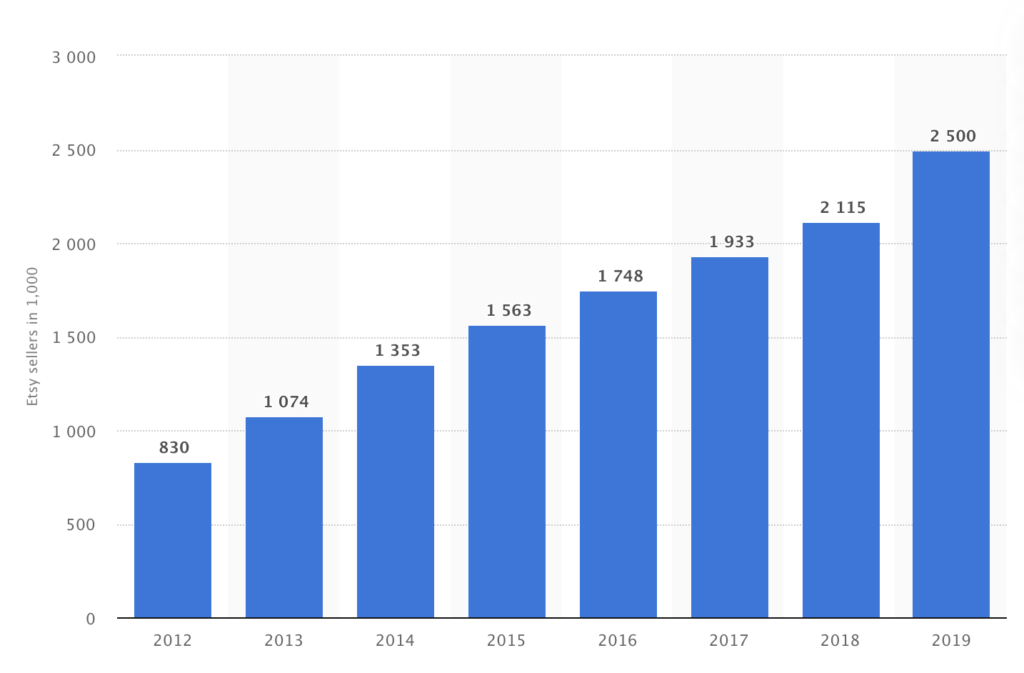
According to Statista, Etsy had over 2.5 million sellers at the end of 2019. That number has continued to grow annually.
Increased Etsy Seller Fees
In 2018, Etsy increased its transaction fee for sellers from 3.5% to 5.0%. Once a product is sold, Etsy now takes a 5.0% cut of the revenue paid. This includes 5% of any shipping cost paid by the customer.
Additionally, the company announced in February 2020 that it would advertise seller’s goods on the internet for free. Though it sounds great, there’s a catch.
Etsy collects a fee of 12% – 15% from each sale that results because of their advertisements. For instance, if Etsy’s advertising lands your product on Google search and a consumer buys through that channel, Etsy collects the additional fees.
Small sellers pay the higher fee of 15%, but they are also able to choose to opt-out of the advertisements. It results in less traffic, but also reduces the fees paid for the sales you do make. It is a business decision to weigh as you start your Etsy shop.
However, Etsy’s top sellers – those making $10,000 per year or more – do not have the option. They will be automatically enrolled in the program, and will be charged 12% on sales that result from an Etsy ad.
Read More: Fees & Payments Policy on Etsy

Prioritizing Free Shipping
Sellers are highly encouraged to offer free shipping in their shops. Shipping prices can be set per product or for the shop as a whole.
Etsy has made it clear that they want sellers to offer free shipping for orders over $35. Shops that comply get priority in searches and advertisements. Shops that do not are pushed further down the search which makes it harder to gain traffic and customers.
For many sellers this means raising prices and running the risk of losing sales and customers. Otherwise, sellers absorb the extra cost themselves. Ultimately, if you are not carefully pricing products for profitability, this could cause losses in your Etsy shop.
As a global marketplace, this policy makes it more difficult for sellers to profit from sales to overseas buyers. Unfortunately, for a seller from a place like South Africa, shipping costs overseas can be exorbitant. With many buyers ordering a single item, it’s just not viable for global traders far from the large markets to ship one item and still make money.

Who Can Sell on Etsy?
Etsy is a global online marketplace open to sellers of all types. Anyone can sell their handmade products, vintage goods (at least 20 years old) and crafting supplies. You can be a small business or operating as an individual.
The Seller’s Handbook focuses more on describing eligible products than detailing any restrictions on age, country, etc. Note that Etsy may change their policies at any time. They may also hold different policies depending on your country of operation. Make sure to check the guide yourself to confirm you are eligible to open a shop.
What to Sell on Etsy
- Handmade/sewn clothes
- Customized goods (Grab yourself a Cricut cutting machine and open shop!)
- Toiletries and Self Care: Soaps, Oils
- Gifts: Christmas ornaments, bridesmaid gifts
- Jewelry, Wigs, Accessories
- Digital Downloads: SVG files, printables, ebooks, etc.
- Stationery, Stickers, Planners, etc.
- Home Décor: Wall Signs, Doormats
- Houseplants, succulents (Yes, live ones!)
- Custom-made cakes, food hampers, vegan chocolate
- Phone cases
What You Cannot Sell on Etsy
The following types of items are prohibited or restricted on Etsy:
- Alcohol
- Tobacco
- Drugs
- Drug Paraphernalia and Medical Drugs
- Animal Products and Human Remains
- Dangerous Items: Hazardous Materials, Recalled Items, and Weapons
- Hate Items: Items that Promote, Support, or Glorify Hatred
- Illegal Items
- Pornography and Mature Content
- Items that Promote, Support, or Glorify Violence
Additionally, sellers may not resell handmade items. This means a seller may not list a handmade item that they didn’t design or make themselves.
How to Start an Etsy Shop
It’s easy to set up a shop on Etsy. First, you follow the steps to create an Etsy account. If you already have an account as a buyer, you can use the same to open your shop. Then, you will set up your shop preferences. That includes language, country, and currency. Also note whether you will be selling part-time or full-time. Not too much else needs to be done before you are ready to launch.
What you need to start a shop
Starting a shop on Etsy is free. If you are interested in opening a shop to see the backend and learn how it works, you can get started without a credit card. The first fee you pay is when you publish a listing ($0.20 each.)
Next you choose your shop name. This can be tricky, so find some tips here.
After that, you’re ready to stock you shop by adding product listings to your shop. Make sure to take quality photographs (at least 1,000 pixels wide) of your products that show them off at their best. Remember, on Etsy this is the only way to distinguish yourself from the other shop owners on the same page.
Now you that you have set up your shop, you must choose payment and billing methods.
Financial Info Needed for Etsy
To choose how you’ll get paid, you must know if your country is eligible to use Etsy Payments. Etsy Payments gives your buyers different options to pay for their order. Then, they consolidate all the payments for you in your Etsy Payment account.
If you’re in a country is not eligible for Etsy Payments, you can use your PayPal account.
Setting up your billing will depend on the country you’re in. You may need to enter a credit or debit card to open your shop. This could be any of the following cards:
- Visa
- Mastercard
- American Express
- Discover
- Carte Bleue (France)
Once you’ve entered your card details, you are ready to open your shop. Just click ‘’open’’.
The web address to get to your shop will be: https://yourshopname.etsy.com or https://www.etsy.com/shop/yourshopname.
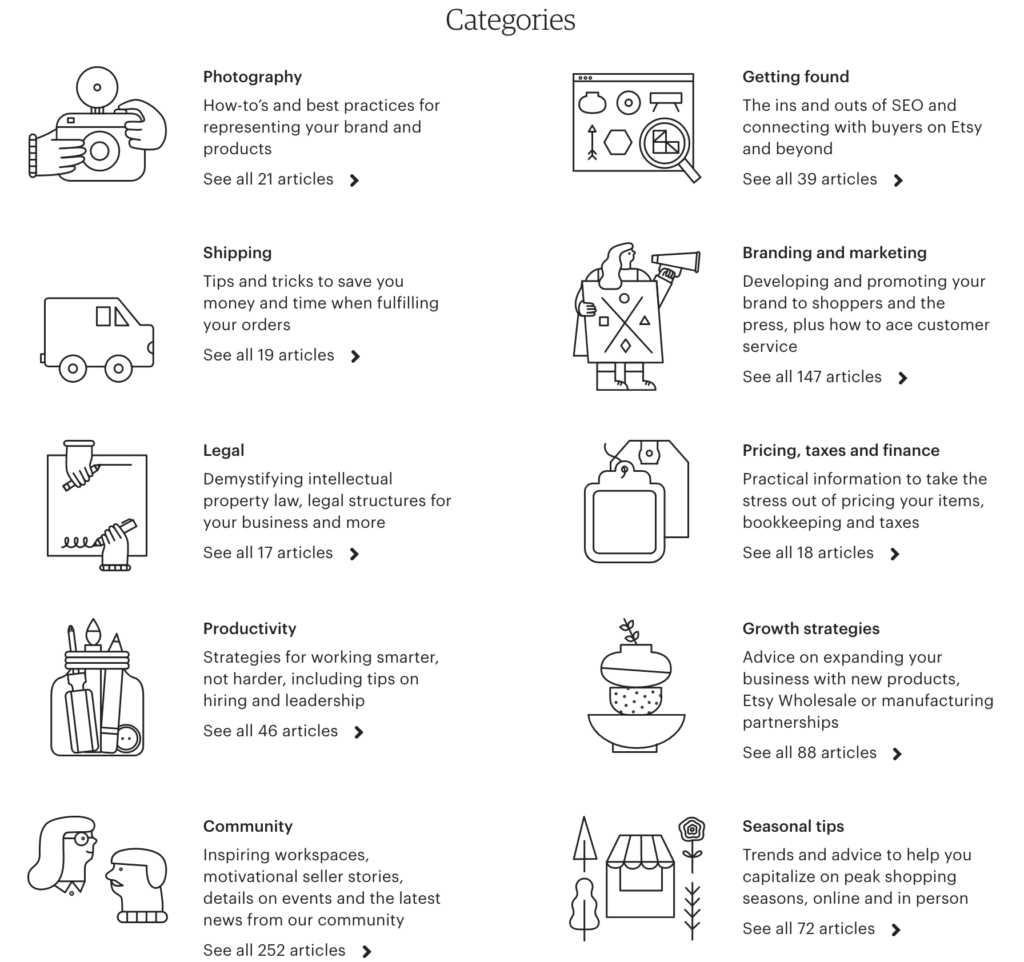
Comparing Etsy to Other Online Marketplaces
Shopify, Etsy and Facebook Marketplace are all popular choices when you want to start your own online business. They all have their own benefits and drawbacks. Here’s a quick comparison.
Etsy vs. Facebook Marketplace
More than 85% of Facebook users reside outside the U.S. and Canada, so it’s a huge global marketplace that reaches many more users than Etsy. That means more buyers than on Etsy.
Most sellers on Etsy source hand-crafted, vintage, collector’s items, and craft supplies. Meanwhile, Facebook Marketplace does not restrict what can be bought and sold – even job offers are allowed. However, these days there are a lot of products for sale on Etsy that scarcely warrant the description ‘’hand-crafted’’.
Facebook Marketplace only provides a place for users to buy and sell and doesn’t handle any payments or shipping. This means there is no guarantee of product quality or non-damage or timely delivery, etc.

Facebook Marketplace concentrates on buyers and sellers in you immediate vicinity – within 40 miles usually, but you can choose up to 100 miles. Their platform warns users not to accept seller offers from a greater distance than 100 miles. Because of the physical closeness, there is no shipping involved. Buyers and sellers usually meet in person. That has to happen in a public space or one should take a friend with.
Another drawback of Facebook Marketplace is unlike Etsy, it doesn’t have a review system so buyers can see who the trustworthy sellers are. At the time of this article, this platform also does not allow the sale of digital products, while Etsy does.
Etsy vs. Shopify
Shopify is an ecommerce platform that allows users to create their own online stores. With Shopify you simply build your very own ecommerce website and upload products. These can be your own products, same as you would sell on Etsy, but also would allow you to sell affiliate products or dropshipping items.
With Etsy, you don’t have your own website. Your products are listed alongside those of other sellers on the platform. Originally Etsy distinguished itself as a marketplace for handmade, vintage and craft items, but that has now changed. After 2013, sellers became allowed to sell manufactured goods as well as handmade items.
One of the drawbacks of Etsy is that it is more difficult to create a strong brand image. Your products are listed among other products and can get lost in the crowd unless customers understand that they must enter very specific search terms to find your products. You can’t create a shop with your own branding, but you can have your own logo with your products.
Conversely, on the Shopify platform, you own the website and can customize every aspect. Unlike Etsy, Shopify does have a monthly fee in addition to paid upgrades for many customization options. Therefore, it is not free to get started or as low cost in the long run, unless you grow a large business.
All of these online marketplaces are simple to join and it’s easy to start a business on them.
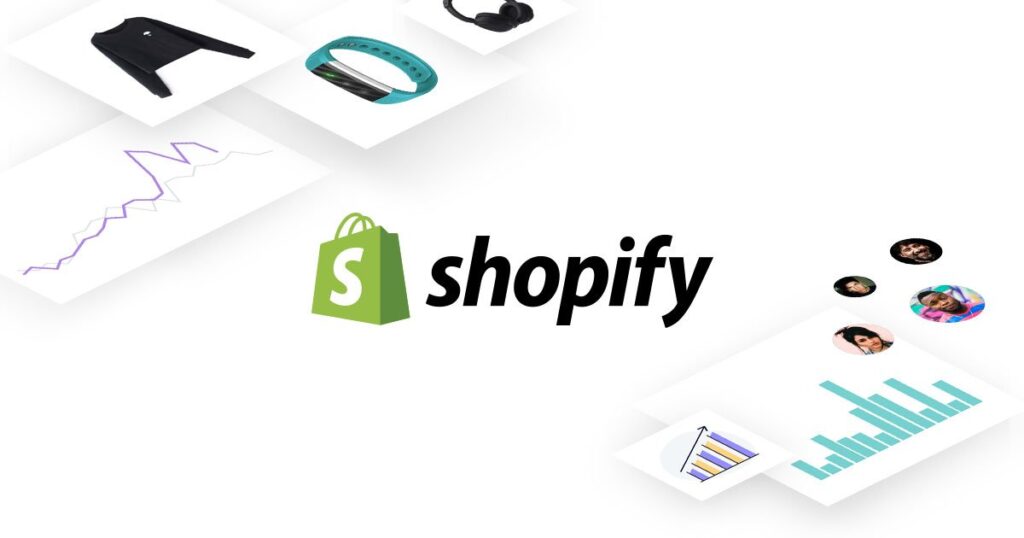
Etsy vs your own website
How does Etsy compare with starting your own website? Wouldn’t it be better to own an independent online store and sell your goods in your own personal space?
Yes, there are definite pros to owning your own ecommerce website. In fact, I always recommend it to business owners. The primary fact to first consider, though, is what stage of business you are in.
When you are just starting out, using a marketplace platform is a valuable way to find your target audience. You can learn what customers are looking for without running up your expenses.
When you build a website, you either need computer skills or the funds to pay someone to design and build it for you. There will also be domain and hosting fees.
[Pro Tip: Grab a free website with Groove while they are still offering them. No monthly fees to have my own shop is exactly how I started building my own website while building my brand on Etsy.]

Even more so, you will need a lot time and skill to spend on SEO to get traction on Google. It can take years for a website to appear on the first page of Google.
Getting a good ranking on Google so people can find you is a tricky business and very time-consuming.
Selling on Multiple Platforms
There is no rule that says you have to stay on just one platform forever. You can even be on multiple platforms at the same time. One trick I use and often recommend to other entrepreneurs is to get started on Etsy immediately, while slowly building your own website on the side.
That way, as you get repeat customers you can start referring them to your own site. This builds your presence and eventually cuts Etsy fees out of the picture.

Etsy Customer Service
Return Policy
Every shop owner on Etsy has a personal policy about refunds, exchanges, and returns. Policies vary from shop to shop.
Buyers are reminded to check a shop’s policies prior to making a purchase. If anything is unclear, customers should contact the seller. Etsy does its best to protect both buyers and sellers, but will lean more towards protecting the buyer if necessary. For that reason, sellers must list their policies as clearly as possible to protect themselves in refund disputes.
Seller Protections
Etsy Seller Protection offers assistance to sellers when there is a dispute between the seller and the buyer.
Shop owners only qualify for Seller Protection if they comply with Etsy’s Seller Protection Policy and are in good standing with Etsy.
Good standing means that the shop owner sells qualifying items, ship orders on time, and promptly responds to messages on Etsy

Cancelling a sale
A shop owner can cancel a sale. When that happens, the buyer receives a full refund. There are steps to follow in order to cancel an order. If the buyer paid through Etsy Payments, the platform takes care of the refund. However, if the buyer paid through another method, like PayPal, the seller must refund them through that same channel.
Lost shipping
Etsy doesn’t hold sellers responsible for shipping delays or errors, provided the seller can prove that they shipped the item on time to the address on the Etsy receipt.
If the item has a tracking number, the buyer can contact the shipping carrier and open a claim. However, Etsy encourages sellers to consider sending a replacement item or a refund for the order as this can build good customer relationships.
A buyer can open a case with Etsy if they have not received their item. If the seller provides proof that the item was shipped, Etsy will close out the case and the seller will be off the hook.
There are always options to insure packages of value. If you are shipping an expensive item, it may be worthwhile to insure the package at shipping. At that point, if it gets lost for longer than 30 days or more, the seller can refund the customer and afterward file as claim.
You can find more useful information here.
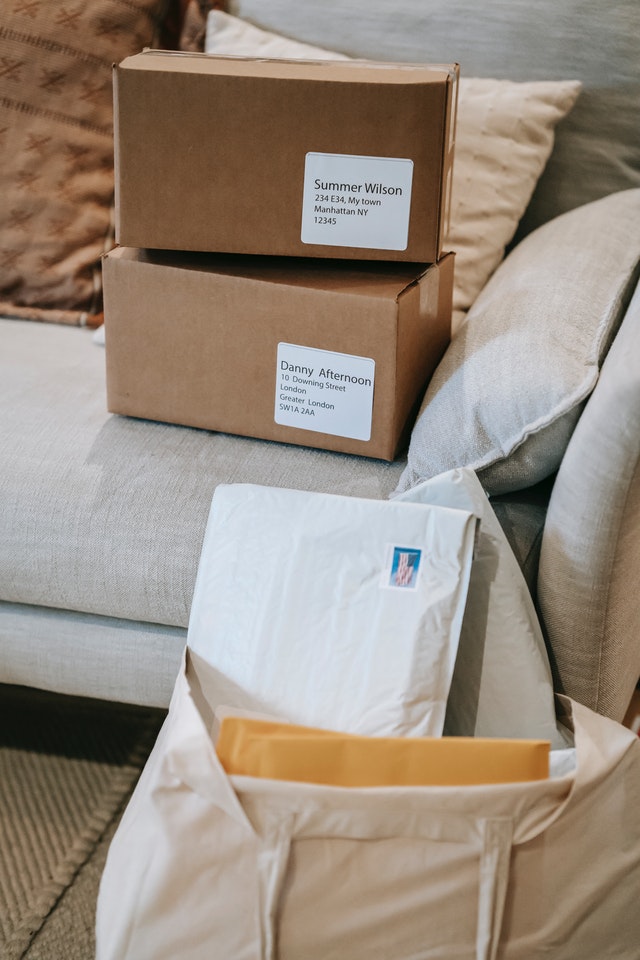
How Etsy Makes Money
Etsy makes a lot of money from fees. The platform generates more than $330 million in revenue from marketplace fees, including listing and transaction fees.
Listing Fee
Etsy charges sellers a listing fee of $0.20 for every product they list for sale in their shop.
If you haven’t opened an Etsy shop yet, make sure to ask a friend for their shared link. By using a referral link, you get 40 free listings and the person who referred you also gets 40 free listings!
Here’s my Etsy referral link if I’ve been a good friend or resource as you start your Etsy seller journey! 🙂

Transaction Fee
When you sell an item through your shop on Etsy, Etsy will charge you a transaction fee of 5% of the price of the item.
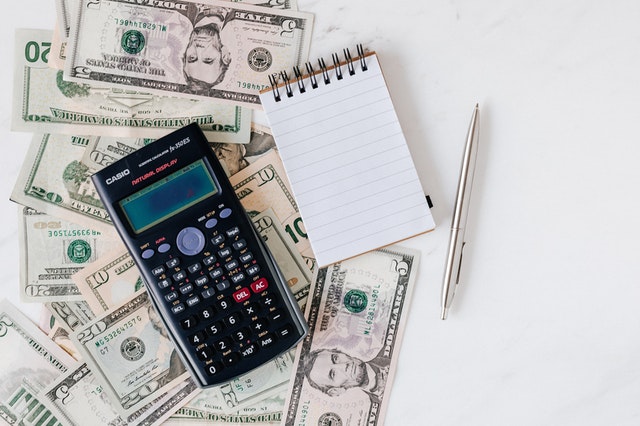
Shipping transaction fee
The company introduced a shipping transaction fee of 5% on the cost of shipping on July 1, 2018. So, if you sell a product on Etsy, you will pay 5% of the transaction cost plus 5% of the shipping transaction cost. This is also another way Etsy uses to encourage sellers to offer free shipping.
Etsy Ads
You can pay to advertise your shop(s) and products on Etsy. You can access this option through the Advertising Dashboard in Shop Manager. There you can set up a limit for the amount you will pay for advertising your business on Etsy.
Off-site Etsy ad fees
Etsy advertises on behalf of sellers on platforms like Facebook, Pinterest, and Google. Sellers who make $10,000 or more per year are automatically included and have to pay 12 % fee on every sale that results because of the advertising undertaken by Etsy.
Shop owners who make less than that, only have to pay 15% fee and they are not obliged to participate, they can opt out.
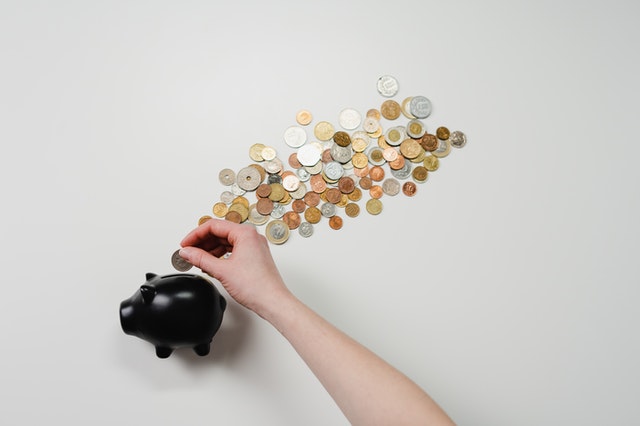
Etsy Seller FAQ
Is Etsy safe/reliable?
Etsy is a publicly traded company that has been in business for 15 years. Millions of sellers have made a living from their shops on Etsy and they were able to do that because consumers keep on buying from them.
Personally, I shop on Etsy and also own two Etsy shops so I am happy to vouch for its reliability as a great method to start an online business.
Just like in any business, fraud can happen and customer relationships are important. As a seller, ensure you deliver on time and work for five-star ratings so buyers continue to trust and shop with you.
What if I need to leave my shop for a few weeks?
There are many reasons why you may need to close your shop for some time. You might be ill, have a family emergency, or as often happens, you need time to catch up with some orders.
When this happens, you can use Vacation Mode to put your shop on hold for a period of time.
While the shop is closed, you’ll have access to your orders, cases, and Messages. You can do refunds, cancel orders, and print Etsy shipping labels, but buyers won’t be able to view any products or make any purchases.

Is it still worth it to sell on Etsy?
When one reads the online forums you quickly come under the impression that Etsy’s days are over. Countless sellers are totally disenchanted with what the platform has become commenting that is has lost its soul – which it appears to have done, judging by the mass-produced stuff it now lists.
But if you go by the figures, then obviously the platform is still worth if for sellers and buyers. In 2019, Etsy’s annual merchandise sales volume totaled $4.97 billion US dollars. Those are not sales figures of a failing company.
Etsy may not be the right or most profitable platform for every shop owner, but it’s obviously still serving a purpose for many.
Ready to Sell on Etsy? Grab my gift – 40 free listings! Click below.




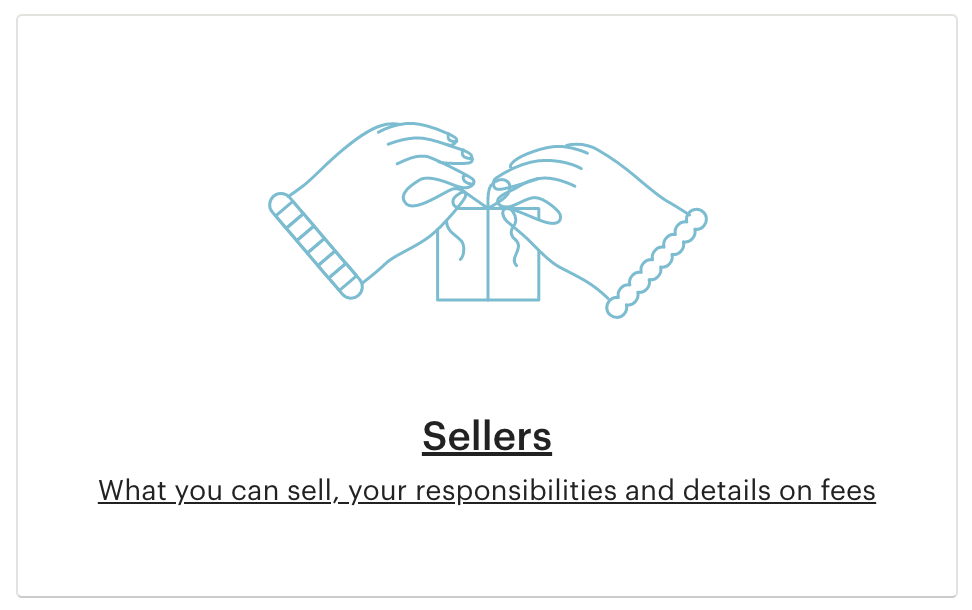



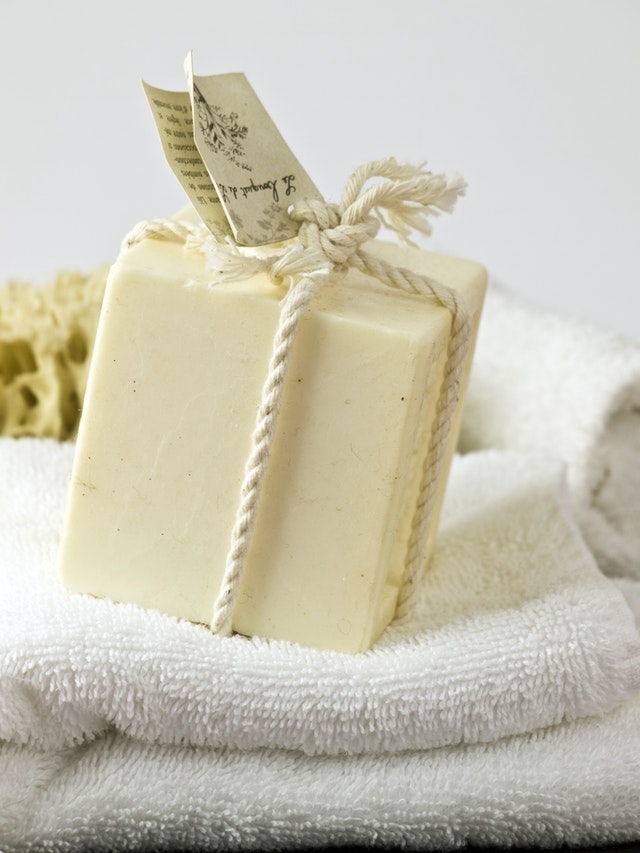
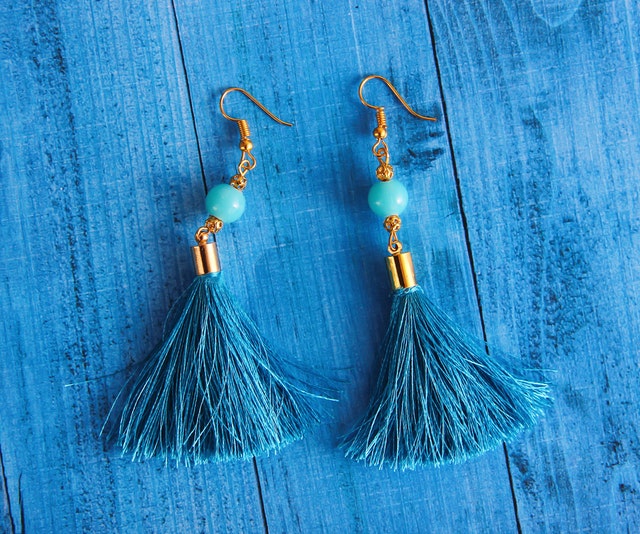




 I create resources for female entrepreneurs and career-driven women striving to break out of their comfort zones and through the glass ceiling.
I create resources for female entrepreneurs and career-driven women striving to break out of their comfort zones and through the glass ceiling.


